“It’s a recreation of living in a compound in the desert, but using the visual language of northern England” Shaun Gardiner discusses his new comics The Boy With Nails for Eyes on Unbound
The latest book that we have discovered via cowd-funding platform Unbound is Shaun Gardiner’s spectacular The Boy With Nails For Eyes. A surreal and dream like book that mixes the nightmarish world of Guillermo Del Toro with the elaborate world building of Neil Gaiman and the quirky artwork of Shaun Tan or Dave McKean. Keen to find out more about this marvellous book we caught up with Shaun to find out the secret behind the Boy With Nails for Eyes.
Tell us a bit about the world of The Boy With Nails for Eyes and the story behind it? Is it based on your own childhood or on general concepts and ideas?
Shaun Gardiner: The world of The Boy with Nails for Eyes really comes from an attempt to capture a feeling.
I was born and grew up in Bahrain, in the Middle East – my family and I were living there during the Gulf War. I was nine when it started. One day this convoy of American humvees and trucks came roaring down the road and onto this patch of waste ground opposite our school. Then helicopters, huge military forklifts, the whole thing. And by the end of the day there was a military base opposite the school (engulfing, to our horror, one of our favourite sweet shops – we were turned back by an American GI later that day, when we went for our sweets).
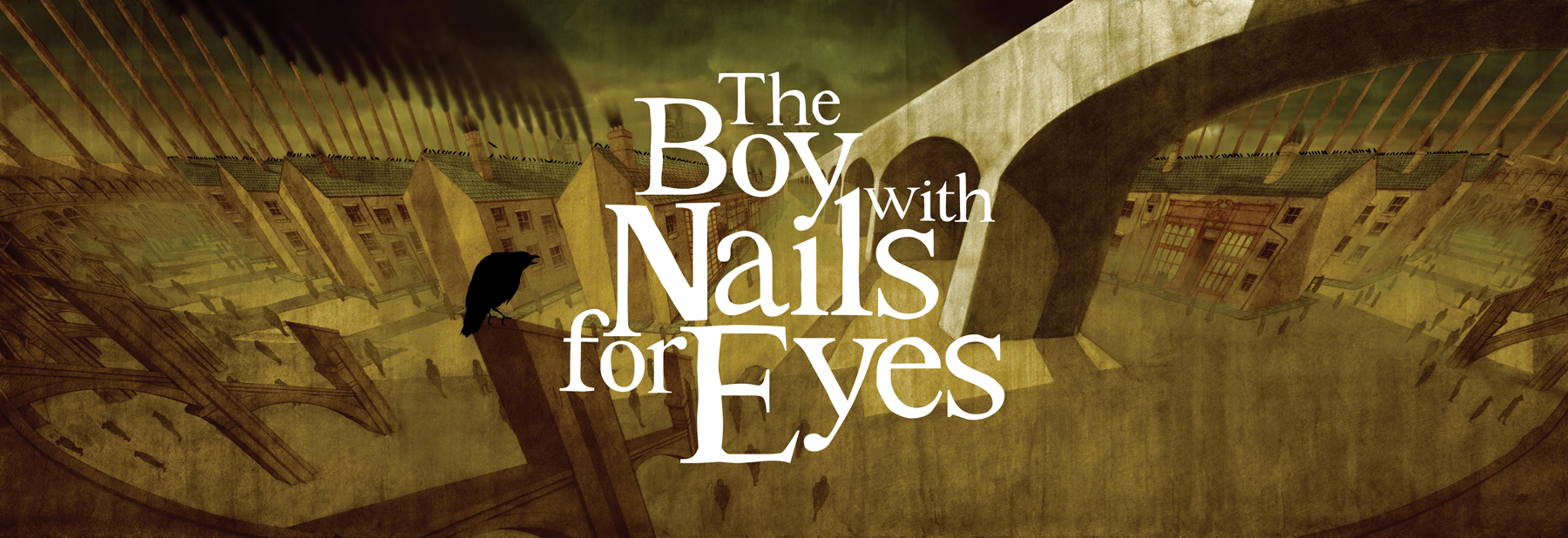
There was a lot of talk about Scud missiles and chemical weapons. One day the Americans gathered everyone in the town hall and they handed out gas masks. We were told to tape Xs across our windows to stop flying glass. A warning siren was installed in the middle of town. TV and radio programmes were interrupted whenever a Scud was launched by Iraq, and we all had to go into our safe rooms with our gas masks until we knew where the missile was going (which was made more exciting by the fact that the Iraqis themselves, reportedly at least, had limited control over that).
One night I woke up to find the rest of the family in my room. My dad was stuffing towels under the door. This was a few days before the war ended. Turned out that Iraq had launched several Scuds and they were heading towards Bahrain. From what I remember Patriot missiles were launched against them and managed to destroy one. A friend of ours went into the desert and came back with some shrapnel from one of the Scuds – I had a piece for years, but I don’t know where it is now.
Another time, I was playing at a friend’s house, and the siren went off. I realised I didn’t have my mask. My friend’s mum hustled us inside and we sat in their safe room, waiting. They all had their masks. I was given a damp towel to put over my head. Turns out we weren’t targeted, but still, it was a – there’s probably a better word but I can’t think of it – *diminishing* experience to sit in the dark with missiles in the air, having heard repeatedly about chemical weapons, chemical weapons, with nothing but a damp towel to protect you.
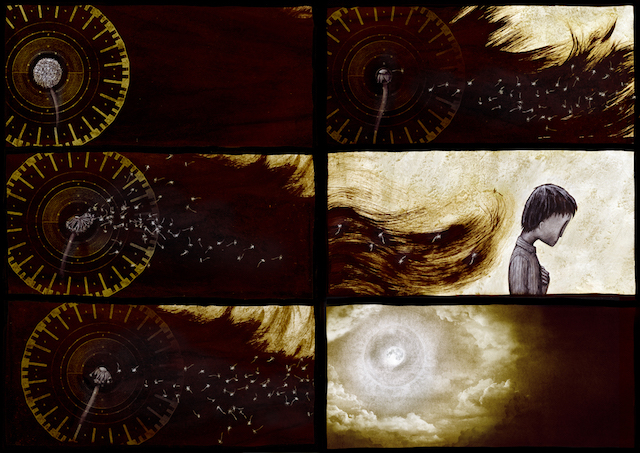
Looking back we weren’t at much risk. But at the time we felt constantly in danger.
Fast forward a decade and September 11th happened, then the War on Terror. My reaction to that, the warmongering, the suspicion – I thought ‘I know this feeling’. The paranoia, the constant grinding awareness, was the same. That diminishing experience. But the Gulf War was short and intense – the War Against Terror has been prolonged and pervasive.
The world of The Boy with Nails for Eyes grew out of that, an attempt to try and imagine a fantastic world built on that feeling, the kind of life that would bring about.
We never seem to see Bobby’s eyes in the preview pages, is that a link to the title or something less obvious? Are you able to explain the meaning of the title without giving the plot away?
SG: It may have been the images I chose just as an accident – Bobby’s eyes are definitely visible in the book! Although admittedly they don’t look like regular eyes.
The title pretty much lets people know what they’re in for – it’s not a happy tale. If I explained it, it would probably get very boring for everyone except me.
I hope that doesn’t sound evasive. To be honest, I prefer not to explain too much – not because of spoilers or anything like that (I’m one of those annoying people who doesn’t mind spoilers, I actually think they improve the experience of a story in a lot of cases) but because I really want people to interpret the story in their own way, and not feel too bound to try to figure out what *I* was trying to say. I will say that I obsessed over pretty much every detail in the story – it all means something, if only to me.
You mention on the Unbound page about how it was inspired by your childhood in Bahrain, however it has a kind of Lowery-esque Northern England feel to it as well. So where and when would you say the story is set? Or is it set nowhere in particular at all?
SG: That’s such a hard question to answer.
Where I was living in Bahrain was basically a large compound, a sort of company village in the middle of the desert, surrounded by chainlink and barbed wire. (Every now and again us kids would go cycling along the perimeter fence, I remember at least one time wild dogs came of the desert to chase us along the other side.) I haven’t really thought of it this way before, but I think the setting of The Boy with Nails for Eyes is also a recreation of that experience, living in a compound in the desert, but using the visual language of northern England.
I lived for some time in the North, though the North East rather than Lowry’s North West. When I first came to the UK I lived in Yorkshire. I went to university in Durham – I met my wife there. Afterward we lived in York for a couple of years – so I got to know the feel of the place pretty well. I liked it there – Yorkshire especially, a lot.
There are also some artistic inspirations, such as Doré’s illustrations for London: A Pilgrimage, and Hayao Mayazaki films, to mention a couple. But those came later.
Anyway, short answer: maybe not our world, but one close to it.

The artwork is just incredible, can you tell us a bit about your process? I assume it’s all digital and you use a lot of compositing and mixed media techniques? How do you plan some of those amazing pages?
SG: First off, thank you! I’m not a very good planner, I have to admit. Lately it’s been a skill I’m learning, and learning the value of. But during the creation of The Boy… I started with only a vague plan, a set of thumbnail pages, some concept sketches and a text version of the story. That led to some interesting ideas developing in the process of creating the story, but it also meant a lot of back-and-forth, things changing mid-flow and, if I’m honest, wasted time. I’m being more careful now, planning more fully, trying to keep the positives – the openness to being off-the-cuff – while limiting the meanders and dead ends.
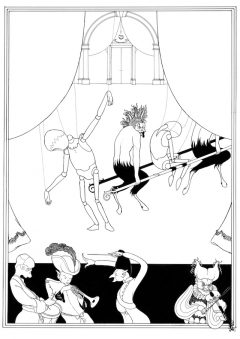 In terms of doing, everything starts in traditional media but always ends up digital – there’s sometimes more of one or the other, but it never happens that one image is fully traditional or fully digital.
In terms of doing, everything starts in traditional media but always ends up digital – there’s sometimes more of one or the other, but it never happens that one image is fully traditional or fully digital.
Usually I start on an image with a pencil outline which I render using diluted Indian ink, then detailing in pencil, chalk, charcoal and paint (actually pretty much anything that sticks to paper).
Once the drawing’s done it goes into Photoshop. First, scanning and stitching (utterly tedious). Then it might just be a case of adding colour and tweaking levels (and fixing mistakes). At other times whole new elements are brought in in Photoshop, either by compositing photos or painting digitally.
The Behemoths image from the prologue makes for a good example. The town at the bottom of the picture is drawn traditionally, as described above. Everything else is digital. The Behemoths themselves are composites of photos I’ve taken over the years – churches, cathedrals and similar buildings. Same with the clouds and the sea. The smoke and some other details were digitally painted. The hardest part was making it all hang together. (I actually produced a video outlining how that image was done, which hopefully gives a pretty good overview of my process – https://www.youtube.com/watch?v=UyRqDgeDQzw.)
Which artists inspire you – I can see a bit of Shaun Tan and Dave McKean in there?!
SG: Those two definitely! Dave McKean is the older and I reckon deeper influence – I love his work on the Sandman covers, and I spent a long time poring over Mr Punch, Signal to Noise, Batman: Arkham Asylum and Cages when I was starting out, getting a feel for how to bring together different media and styles. He’s a master, not only at combining disparate elements but doing so in a way that feels meaningful, not just whimsical. I tried to take that and develop it in my own way.
Shaun Tan I came to later, actually some time after I’d started work on the comic. I love his approach to world-building in books like The Arrival, letting the background detail do the work, allowing the reader to fill in the gaps in terms of how this setting functions, so you can develop for yourself an intimate sense of how it feels.
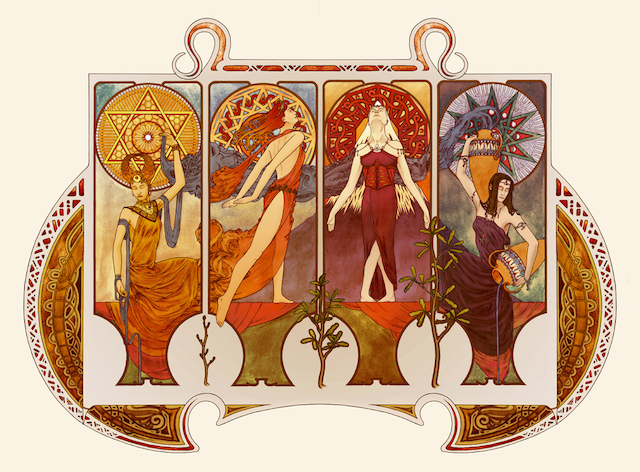
I’ve already mentioned Doré. There are a lot of other artists I admire, or have at some time – the Surrealists and the Symbolists. Giger is a huge influence, I got into him after watching Alien, far too young. There are some artists whose work is directly referenced in The Boy with Nails for Eyes – Alphonse Mucha, Arthur Rackham, Aubrey Beardsley. Probably there are too many to mention who’ve had some influence. There are fiction writers too, of course – Ursula Le Guin would probably top the list. Other than that I read a fair amount of philosophy – Nietzsche, Kierkegaard, Arendt.
I think my greatest single influence is William Blake, for all that my work doesn’t look like his. It’s his marriage of art and text. Removing either would completely impoverish his work, yet the way image and text relate to one another isn’t clear cut. Often they complicate each other rather than simply reinforcing or reduplicating one another. Sometimes they seem antagonistic. It makes for an endlessly rich reading experience that, for all that I love comics, doesn’t seem to be done in them very often – in comics the images usually do the heavy lifting in terms of narrative, while the text is a supplement to that. Blake’s way is much more rich, as far as I see it, and that’s the approach I try to look to.
How did you become involved with Unbound and what is it about their crowd-funding model that made you choose it compared to Kickstarter or Patreon?
SG: I got involved in Unbound through one of their open pitching sessions on Twitter. I actually pitched another book completely, an illustrated poem about the death of Alan Kurdi. While I was discussing that project with my editor there, Lizzie Kaye, I mentioned that I had this other thing, The Boy with Nails for Eyes, and would she like to see it? She had a look and got back to me ‘Let’s do this!’ – and here we are.
For me, crowd-funding was something I was always wary of. I admit I don’t take naturally to social media, I’m generally awkward at it. I’ve had to learn to do it anyway, and even to enjoy it – having Unbound’s name attached to the project has made a difference. There’s the added benefit that they handle distribution, promotion, all the things that a publisher takes on and which they’ll do much better than I ever could. Plus it’s great to have someone who’s supportive of your work, believes in it enough to take it on as they have, and who’ll criticise it if they need to.
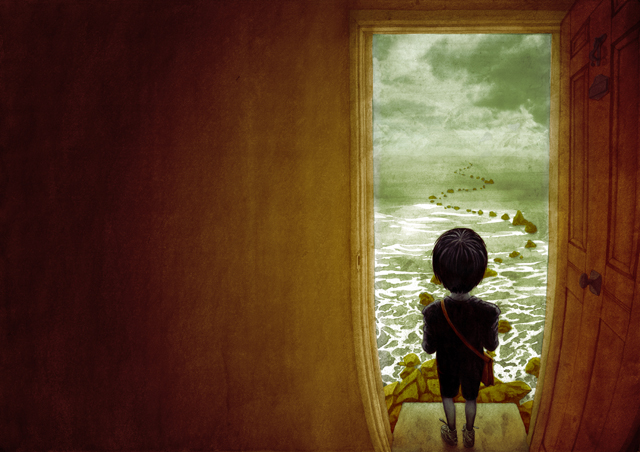
How big a book will The Boy With Nails For Eyes be and when can we expect it to be finished?
SG: The first volume, the book being crowd-funded now, is one third of the story. It’s about two hundred pages, and I expect the volumes to come will each be about the same length. I’ve already started work on the second volume – a solid draft is near half-complete – and I hope to begin work on that properly this year. With the learning I’ve done putting together the first volume, I know the second will go a lot quicker.
Once The Boy with Nails for Eyes is done entirely I have ideas for sequels, I think two of them. The second one will be set in a different part of the same world – another, smaller town called, for now, Gun – and will feature a character called Mary, who’s yet to enter the story but will feature in The Boy….
The entire thing will be an epic – I know it’ll keep me busy for years. It’ll be over 1,000 pages. One thing I know for certain is the ending. It’ll be appropriately apocalyptic.
You can support The Boy With Nails For Eyes on Unbound here and find out more about Shaun’s work here



July 29, 2025 @ 6:13 pm
I don’t think the title of your article matches the content lol. Just kidding, mainly because I had some doubts after reading the article.
September 3, 2025 @ 8:15 pm
Your article helped me a lot, is there any more related content? Thanks!
October 8, 2025 @ 8:36 pm
You’ve got a new fan here! Watch ptv sports live app — live cricket, football, tennis, and more. See schedules, live scores, expert analysis, and replays with fast, reliable HD streaming anywhere.
November 12, 2025 @ 7:23 pm
Can you be more specific about the content of your article? After reading it, I still have some doubts. Hope you can help me.
December 12, 2025 @ 7:56 am
whoah this weblog is wonderful i like reading your posts. Keep up the good work! You recognize, many persons are looking around for this info, you could help them greatly.